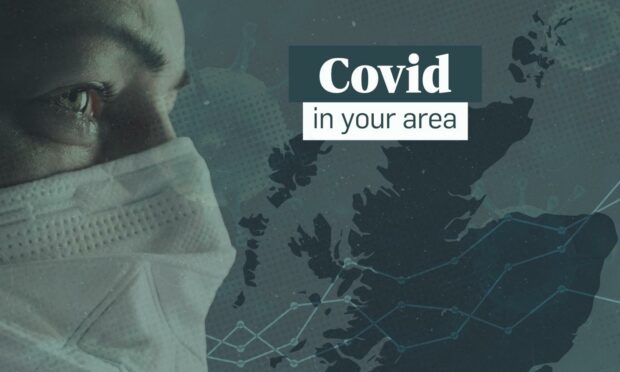Over a month on since the now dominant Omicron variant was detected in Scotland, Covid cases have reached record highs across the country.
Due to its rapid transmission, more than 2,000 people in the north and north-east have tested positive for Covid since the start of the new year.
Hospital numbers and number of deaths have also increased; the extent of which remains to be seen as there is still some uncertainty about how high case numbers will translate into hospital admissions.
Scotland’s National Clinical Director, Jason Leitch, has warned that Omicron cases may not peak until the end of January.
In an attempt to curb the spread and ease pressure on health services, the Scottish Government has introduced new restrictions in recent weeks.
Our interactive maps below show the case rate by intermediate zone for Aberdeen, Aberdeenshire, Highland and Moray. The islands have not been included as case numbers tend to be very low and are often suppressed as a result.
Each intermediate zone (IZ), represents an area, quite often a neighbourhood, within each local authority.
Hovering over each area will give additional information including the population of each neighbourhood, how many positive cases have been recorded there in the past seven days, and the seven-day case rate per 100,000 population – a measure which is used to compare areas with different populations against each other to accurately track the spread of the virus.
Below includes details for case rates accurate as of January 3, which was the latest information at the time of writing, as this data is subject to a three-day lag in being uploaded by Public Health Scotland.
We have compared case rates to previous weeks to provide context about whether cases are rising or falling in your area.
What are case rates like in Aberdeen?
The below chart shows the case rates for each neighbourhood in Aberdeen.
All of Aberdeen’s 49 neighbourhoods saw an increase in Covid case rates compared to last week. Only two neighbourhoods recorded seven day case rates below 1,000 per 100,000 population, with rates in the 900s.
The three neighbourhoods in the city with the highest case rates were Denmore, Bucksburn South and Kingswells.
Denmore had a rate of 2,693 per 100,000 population, with a total of 105 positive cases in the previous seven day period, out of a population of 3899.
Meanwhile, Bucksburn South had a case rate of 2,482 per 100,000 population, with 115 Covid-19 cases out of a population of 4,634 and Kingswells had a case rate of 2,279 per 100,000 population. It had 142 positive cases in a population of 6,232 in the previous seven days.
Last week, the top three neighbourhoods were Denmore, Kingswells and City Centre West.
What are case rates like in Aberdeenshire?
The below chart shows the case rates for each neighbourhood in Aberdeenshire.
Just six neighbourhoods in Aberdeenshire recorded case rates below 1,000 per 100,000 population. Only one of Aberdeenshire’s 59 neighbourhoods, Fraserburgh Smiddyhill, saw a decrease in case rates compared with last week.
In Aberdeenshire, there were several neighbourhoods with case rates of more than 2,000 per 100,000 population.
The top three were Blackburn, Fetteresso, Netherley and Catter and Newtonhill.
Blackburn recorded a case rate of 2,536 with 87 positive cases in a population of 3,430 in the previous seven days.
Fetteresso, Netherley and Catter had a rate of 2,447 per 100,000 population, with 119 positive cases in its population of 4,864. In Newtonhill, the case rate was 2,328 per 100,000 population, with 67 confirmed cases out of 2,878 people.
Last week, the top three neighbourhoods were Newmachar and Fintray, Banchory West and Peterhead Ugieside.
What are case rates like in Moray?
The below chart shows the case rates for each neighbourhood in Moray.
All 24 neighbourhoods in Moray have increased case numbers compared to last week and have recorded case rates above 1,000 per 100,000 population.
Several neighbourhoods have case rates above 3,000 per 100,000 population.
In Moray, the neighbourhoods with the highest case rates were New Elgin West (with the 5th highest case rate in Scotland), Elgin Bishopmill East and Ladyhill and Burghead, Roseisle and Laich.
New Elgin West had a case rate of 3,820 per 100,000 population, with 155 positive cases in the previous week out of a population of 4,058. Elgin Bishopmill East and Ladyhill had a slightly lower case rate of 3,362 per 100,000 population, and saw 109 cases in a population of 3,242.
Burghead, Roseisle and Laich recorded a case rate of 3,323 per 100,000 population, with 183 positive cases in a population of 5,507.
Last week, the top three neighbourhoods were Lossiemouth West, Elgin Bishopmill East and Ladyhill and Rafford, Dallas, Dyke to Dava.
What are case rates like in the Highlands?
The below chart shows the case rates for each neighbourhood in the Highlands.
All of the 56 neighbourhood divisions in the Highlands have recorded increased case numbers this week.
Inverness is hardest hit; the top three neighbourhoods in the Highlands with the highest case rates were Inverness Slackbuie, Inverness Westhill and Inverness Smithton.
Inverness Slackbuie had a case rate of 3303 per 100,000 population, and 122 positive cases in its 3,694 population.
Inverness Westhill had a case rate of 3,087 per 100,000 population and 194 confirmed cases out of 6,284 people. Inverness Smithton had a case rate of 3,034 per 100,000 population and 91 cases in a population of 2,999.
Unusually for the Highlands, there were no areas for which the data was suppressed due to low recorded cases. The majority of areas (47 out of 56 neighbourhoods) recorded case rates above 1,000 per 100,000 population.
Last week, the top three neighbourhoods were Inverness Central, Raigmore and Longman, Inverness Crown and Haugh and Inverness Slackbuie.
How does the north and north-east compare to the rest of Scotland?
The below chart shows the top 10 neighbourhoods in Scotland with the highest case rate per 100,000 population.
New Elgin West, in Moray, recorded the 5th highest case rate of Scotland’s 1,279 neighbourhood divisions.
